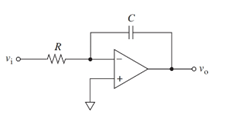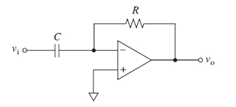
(a)
Interpretation:
The anticipated output of the circuit is to be stated.

Concept introduction:
The sine wave voltage is a type of voltage that can be represented with the sine function. The average value of the sine wave over a complete cycle is zero, as both the positive and negative half the wave cancel out each other.
(b)
Interpretation:
The anticipated output of the circuit is to be stated.

Concept introduction:
The sine wave voltage is a type of voltage that can be represented with the sine function. The average value of the sine wave over a complete cycle is zero, as both the positive and negative half the wave cancel out each other.
(c)
Interpretation:
The anticipated output of the circuit is to be stated.

Concept introduction:
The sine wave voltage is a type of voltage that can be represented with the sine function. The average value of the sine wave over a complete cycle is zero, as both the positive and negative half the wave cancel out each other.
(d)
Interpretation:
The anticipated output of the circuit is to be stated.

Concept introduction:
The sine wave voltage is a type of voltage that can be represented with the sine function. The average value of the sine wave over a complete cycle is zero, as both the positive and negative half the wave cancel out each other.
(e)
Interpretation:
The anticipated output of the circuit is to be stated.

Concept introduction:
The sine wave voltage is a type of voltage that can be represented with the sine function. The average value of the sine wave over a complete cycle is zero, as both the positive and negative half the wave cancel out each other.
Trending nowThis is a popular solution!

Chapter 3 Solutions
Principles of Instrumental Analysis, 6th Edition
- What is the purpose of waiting 1s after a voltage pulse before measuring current in sampled current voltammetry?arrow_forwardFIGURE 24-8 2µF 4µF HH 3µF HH 6µF 90V A system of capacitors is connected across a 90 V DC voltage source as shown in Fig. 24-8. What is the equivalent capacitance of this system?arrow_forward2. The following data were obtained for a voltage measurement, in mV, on a noisy system: 1.27, 1.54, 1.45, 1.63, 1.68, 1.39, 1.40. Assuming the noise is random, and s-0.145, what is the signal-to-noise ratio? A) B) C) D) 0.098 1.48 10.2 0.228arrow_forward
- The table shows a series of standard additions of Cu(II)to acidified tap water samples measured by anodic stripping voltammetry at a platinum electrode. The unknown and all standard additions were made up to the same final volume. 1. Plot absorbance as a function of the concentration of Cu (II) standard. Determine the equation of the line and the X intercept. Find the concentration of Cu(II) in the water.arrow_forwardWould the electric current produced by these fruits/vegetables in this experiment last forever with such a set-up? Justify your answerarrow_forwardThe observed intensity of light (I) after passing through the sample cell is 0.176 of the initial intensity (I0) from the light source. The absorbance (A) of the sample solution is Report your answer to 3 significant figures.arrow_forward
- Differentiate between Fermi level and Fermion.arrow_forwardAt a frequency above the frequency required to overcome the work function, increasing the light intensity causes the current to increase / decrease / remain the same.arrow_forwardElectrochemical detection is commonly used in combination capillary electrophoresis systems. This is a type of hydrodynamic voltammetry called flow injection, where it has been shown that ilim a U1/3, where U is the flow rate of the solution. Flow analysis of a urine sample at a thin-layer amperometric detector, with a flow-rate of 1.25mL/min, yielded a limiting current value of 1.6µA for its unknown uric acid content. A larger current of 2.4µA was observed for a sample containing 1 × 10-4 M uric acid and flowing at a rate of 0.9mL/min. Calculate the original concentration of uric acid in the samplearrow_forward
- Which of the following statements results in an increased magnetic field strength inside a coil with N turns, radius R, and current I? Reduce the number of turns of wire in the coil. All of the above. Insert an iron rod into the middle of the coil. Reduce the current in the coil.arrow_forwardWhat is the kinetic energy of an electron that has been accelerated through a potential difference of 10.0 kV?arrow_forwardThe absorption spectra of two colored substances A and B are determined and the following data obtained using 1.00-cm cell: Solution Molarity A450 nm A750 nm A alone 5.0 x 10-4 0.800 0.100 B alone 2.0 x 10-4 0.100 0.600 A + B Unknown 0.600 1.000 1. Using the molarity and absorbance data for the solution containing A alone, calculate the molar absorptivities of A at 450 nm and 750 nm. 2. Using the molarity and absorbance data for the solution containing B alone, calculate the molar absorptivities of B at 450 nm and 750 nm. 3. Calculate the concentrations of A and B in the unknown solution.arrow_forward
 Principles of Instrumental AnalysisChemistryISBN:9781305577213Author:Douglas A. Skoog, F. James Holler, Stanley R. CrouchPublisher:Cengage Learning
Principles of Instrumental AnalysisChemistryISBN:9781305577213Author:Douglas A. Skoog, F. James Holler, Stanley R. CrouchPublisher:Cengage Learning Principles of Modern ChemistryChemistryISBN:9781305079113Author:David W. Oxtoby, H. Pat Gillis, Laurie J. ButlerPublisher:Cengage Learning
Principles of Modern ChemistryChemistryISBN:9781305079113Author:David W. Oxtoby, H. Pat Gillis, Laurie J. ButlerPublisher:Cengage Learning

